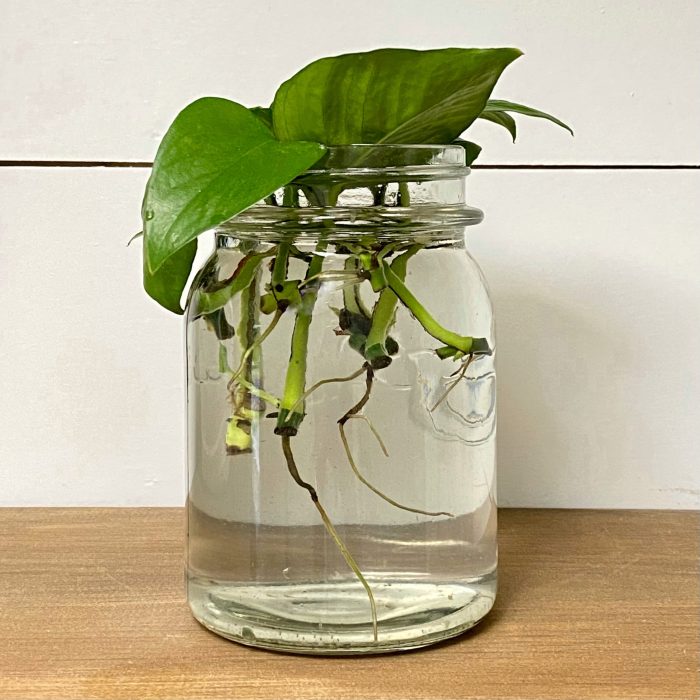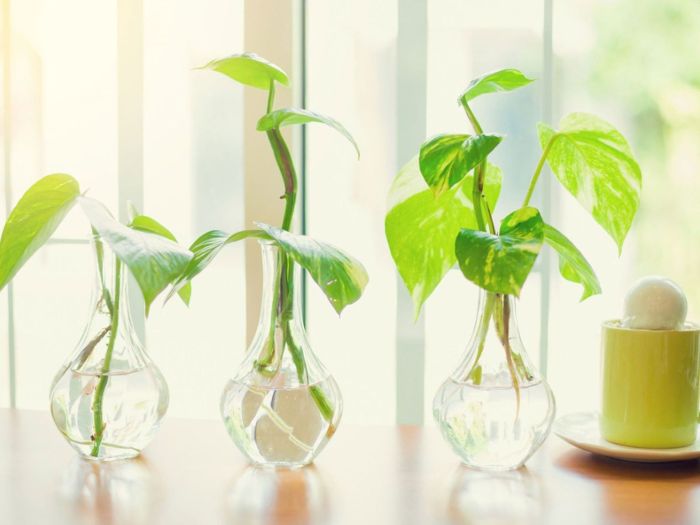How to Plant Pothos in Water
Propagating Pothos in Water: A Step-by-Step Guide
How to plant pothos in water – Growing pothos from cuttings in water is a simple and rewarding way to propagate these popular houseplants. This method allows you to easily multiply your pothos collection and enjoy the process of watching new roots develop. This guide will walk you through each step, from selecting the perfect cutting to transplanting (optional) into soil.
Choosing the Right Pothos Cutting
Selecting a healthy cutting is crucial for successful water propagation. The ideal cutting should exhibit vibrant, disease-free foliage and a firm, non-woody stem. A cutting with several nodes (the points on the stem where leaves emerge) will increase the chances of successful root development.
To prepare the cutting, select a stem section approximately 4-6 inches long with at least two nodes. Use clean, sharp pruning shears or a knife to make a clean, angled cut just below a node. Remove the lower leaves from the bottom node to prevent them from rotting in the water. This leaves the node exposed, the point where roots will emerge.
Preparing the Water and Container
The type of water and container you choose significantly impacts the success of pothos propagation. Using clean, chlorine-free water is essential to prevent the development of harmful bacteria or fungi. Filtered or distilled water is ideal, allowing the cutting to focus on root development without battling contaminants. The container should be clean, transparent (to monitor root growth), and large enough to comfortably hold the cutting without overcrowding.
Regular water changes are vital to maintain water quality and prevent bacterial growth. Aim to change the water every 2-3 days, or more frequently if you notice cloudiness or an unpleasant odor.
| Container Type | Pros | Cons | Notes |
|---|---|---|---|
| Glass | Aesthetically pleasing, allows easy root observation | Can be easily knocked over; susceptible to algae growth if not cleaned regularly | Choose a stable, wide-based glass. |
| Ceramic | Durable, attractive, retains water temperature better than glass | Heavier than glass or plastic; may harbor bacteria if not thoroughly cleaned | Ensure the ceramic is non-porous. |
| Plastic | Lightweight, inexpensive, readily available | Less aesthetically pleasing; may leach chemicals into water if low-quality | Choose a food-grade plastic container. |
Planting the Pothos Cutting in Water

Source: caligirlinasouthernworld.com
Submerge only the bottom node of the cutting in the water. Keeping the leaves dry prevents them from rotting. The water level should be just enough to cover the node; avoid submerging more of the stem, as this can lead to rotting. Ensure that the container is large enough to accommodate the cutting without overcrowding; multiple cuttings in a small container compete for resources and increase the risk of rot.
Providing Optimal Growing Conditions, How to plant pothos in water

Source: gardeningknowhow.com
Pothos cuttings need indirect, bright sunlight to thrive. Direct sunlight can scorch the leaves. An ideal temperature range for propagation is between 65-75°F (18-24°C). Maintain a consistent water level by adding more water as needed, ensuring that the bottom node remains submerged. Regularly inspect the water for cloudiness or unpleasant odors and change it promptly.
Visual Representation of Ideal Setup: Imagine a clear glass jar, about 8 inches tall and 4 inches wide, filled with about 2 inches of filtered water. A pothos cutting with two nodes is placed in the water, the bottom node submerged. The jar is positioned near a sunny window, but shielded from direct sunlight by a sheer curtain. The overall impression is one of cleanliness and brightness.
Monitoring Root Development and Growth
Root development typically begins within 2-4 weeks, with small, white roots emerging from the submerged node. Healthy roots are white or light-colored, firm, and numerous. Root rot, characterized by brown, mushy roots, indicates a problem with water quality or overwatering. Leaf discoloration, such as yellowing or browning, can signify nutrient deficiencies or disease. Regularly inspect the cutting for these signs.
- Signs of a Healthy Pothos Cutting: Vibrant green leaves, firm stem, numerous white roots, clear water.
- Signs of an Unhealthy Pothos Cutting: Yellowing or browning leaves, soft or mushy stem, brown or black roots, cloudy or foul-smelling water.
Transplanting to Soil (Optional)
Once the pothos cutting has developed a robust root system (at least 2-3 inches long), it can be transplanted into soil. This gradual transition helps the plant adapt to its new environment. Pothos grown in water require less frequent watering compared to those in soil, as the roots are constantly surrounded by moisture.
Step-by-Step Guide (described, no images): 1. Prepare a pot with well-draining potting mix. 2. Gently remove the pothos cutting from the water. 3.
Plant the cutting in the soil, ensuring the root system is covered. 4. Water thoroughly and place the pot in a location with indirect sunlight. 5. Monitor the plant’s moisture level and adjust watering as needed.
The plant should be gradually introduced to the soil to avoid shock.
User Queries: How To Plant Pothos In Water
Can I use tap water?
It’s best to use filtered or distilled water to avoid chlorine and other chemicals that can harm the cutting. Tap water can be used, but let it sit out for 24 hours to allow chlorine to dissipate.
How often should I change the water?
Change the water every 2-3 days to prevent bacterial growth and maintain cleanliness. This also ensures the plant receives fresh nutrients.
What if my pothos cutting starts to wilt?
Propagating pothos in water is simple; just place a cutting in a jar of water, changing the water regularly. The frequency of watering, however, differs greatly depending on the plant; for instance, understanding how much to water a jade plant, as detailed in this helpful guide: how much to water a jade plant , is crucial for its health.
Returning to pothos, ensure the water level remains consistent to encourage root development.
Wilting can indicate insufficient water or inadequate light. Ensure the cutting is submerged adequately and placed in a location with bright, indirect sunlight.
My pothos cutting has developed brown spots on the leaves. What’s wrong?
Brown spots can signify overwatering, underwatering, or exposure to too much direct sunlight. Adjust your watering schedule and lighting accordingly.




















